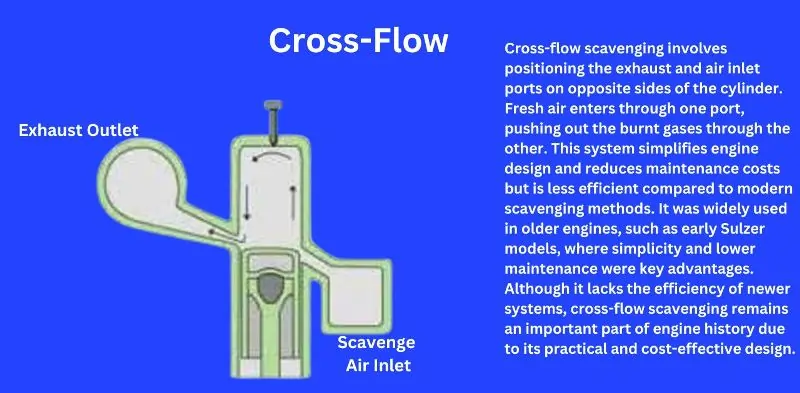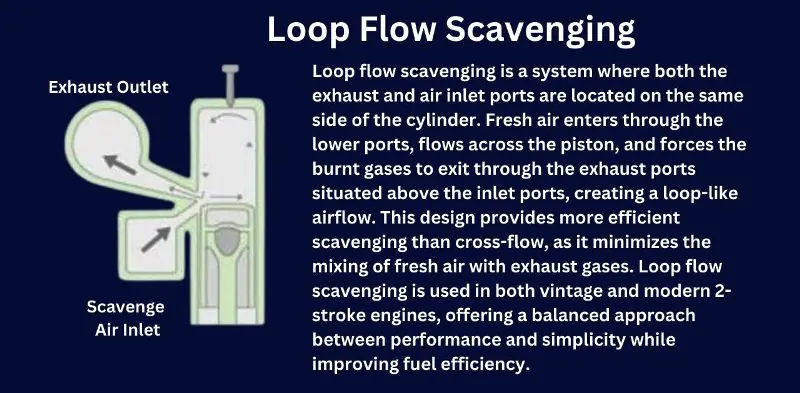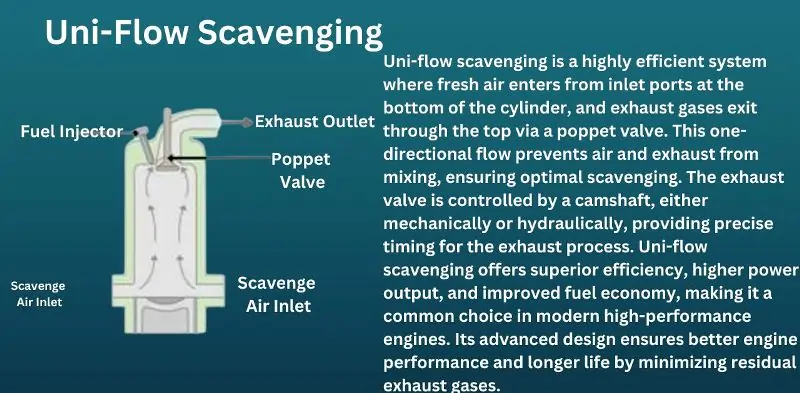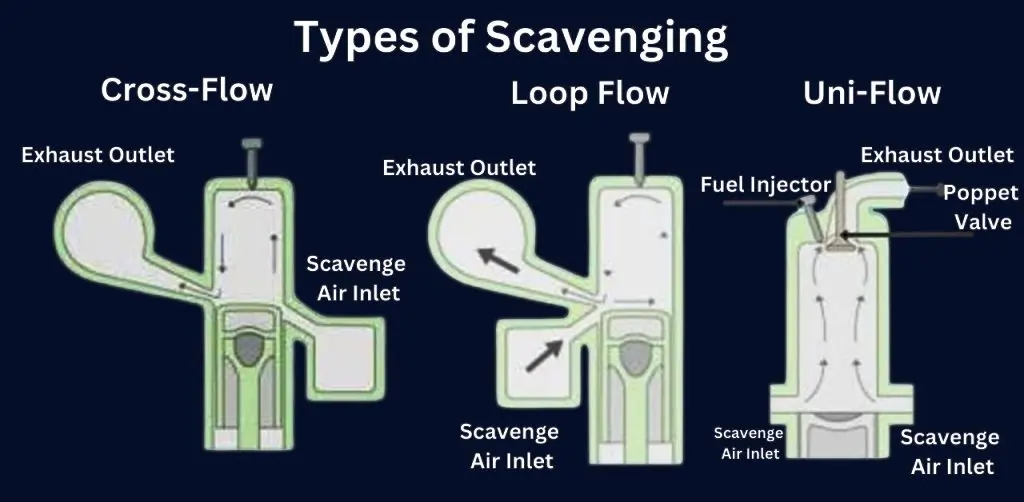Engine Scavenging
Scavenging is a crucial process in internal combustion engines, replacing burnt gases with fresh air inside the cylinder after combustion. This exchange is essential for maintaining engine efficiency, ensuring proper combustion, and minimizing exhaust emissions. Without effective scavenging, engines would suffer from poor performance, reduced power output, and increased fuel consumption.
The importance of scavenging becomes even more apparent when comparing 2-stroke and 4-stroke engines. In 2-stroke engines, scavenging plays a dual role by handling both exhaust and air intake processes simultaneously, as there are no separate strokes for these functions. This differs from 4-stroke engines, which have distinct exhaust and inlet strokes. As a result, scavenging in 2-stroke engines is vital to their performance and efficiency, making it a more complex and critical part of their operation. Understanding these differences helps in optimizing engine performance across various applications.
What is Engine Scavenging?
Engine scavenging is the process of clearing burnt gases from the cylinder after combustion and replacing them with fresh air. This is essential for maintaining optimal engine performance, as leftover exhaust gases can disrupt the combustion process. Effective scavenging ensures that fresh air enters the cylinder, allowing the fuel to burn completely. This improves engine efficiency, reduces harmful emissions, and boosts power output. Without proper scavenging, the engine would experience incomplete combustion, leading to lower performance, higher fuel consumption, and increased wear on engine components. Therefore, scavenging plays a vital role in sustaining engine health and efficiency.
No Separate Exhaust and Inlet Stroke in 2-Stroke Engines
Overview of 2-Stroke Engine Design
In a 2-stroke engine, the design is simplified compared to 4-stroke engines, making it lighter and capable of producing power with every revolution of the crankshaft. This design allows for a more compact engine with fewer moving parts, resulting in a higher power-to-weight ratio.
Absence of Distinct Exhaust and Inlet Strokes
Unlike 4-stroke engines, which have separate exhaust and inlet strokes, 2-stroke engines combine these functions into one continuous process. This means there are no distinct strokes dedicated to expelling exhaust gases or drawing in fresh air.
Scavenging Replaces Both Functions
In a 2-stroke engine, scavenging becomes a critical part of the cycle, as it handles the task of removing burnt gases and bringing in fresh air simultaneously. Proper scavenging is essential for maintaining engine efficiency and performance.
Timing Comparison Between 2-Stroke and 4-Stroke Engines
Shorter Timing in 2-Stroke Engines
In 2-stroke engines, the timing is significantly shorter—about one-fourth that of 4-stroke engines. This is because a 2-stroke engine completes a full power cycle in just two strokes (one revolution of the crankshaft), while a 4-stroke engine requires four strokes (two revolutions) to complete the same cycle.
Implications of Shorter Timing
The shorter timing in 2-stroke engines means that all engine processes—intake, compression, combustion, and exhaust—occur in a more condensed timeframe. This leads to faster cycles and quicker power delivery, allowing for more frequent power generation with each revolution.
Impact on Power-to-Weight Ratio and Efficiency
Due to the faster power cycles, 2-stroke engines have a higher power-to-weight ratio than 4-stroke engines, making them more powerful for their size. However, the shorter timing can also lead to reduced fuel efficiency and increased wear on engine components, requiring effective scavenging to maintain optimal performance.
Types of Scavenging Systems
2-stroke engines rely on effective scavenging to replace burnt gases with fresh air. There are three primary scavenging systems used in these engines, each with unique designs and applications:
Cross-Flow Scavenging

Description
In cross-flow scavenging, the exhaust and air inlet ports are arranged around the lower end of the cylinder liner. The inlet and exhaust ports are positioned opposite each other, allowing fresh air to flow into the cylinder while the burnt gases are expelled out in a cross-wise manner. This design enables a relatively straightforward scavenging process by using the natural flow of air to push out exhaust gases and draw in fresh air.
Advantages
- Simple Engine Construction: The arrangement of ports simplifies the engine design, reducing the number of components involved in the scavenging process.
- Reduced Maintenance Costs: With fewer moving parts and a simpler design, engines utilizing cross-flow scavenging tend to be easier and less expensive to maintain over time.
Historical Use
Cross-flow scavenging was commonly used in older engine models, particularly in early Sulzer engines. While efficient for its time, it has been largely replaced by more advanced scavenging methods in modern engines.
Visual Aid
A diagram or visual representation can help illustrate the arrangement of ports and airflow direction in cross-flow scavenging, offering a clearer understanding of this system’s operation.
Loop Flow Scavenging

Description
In loop flow scavenging, both the exhaust and inlet ports are located on the same side of the cylinder. Fresh air enters through the lower inlet ports, passes over the piston, and forces the burnt gases out through the exhaust ports located above the inlet ports. This creates a loop-like motion of airflow, which helps to efficiently expel exhaust gases while drawing in fresh air for the next combustion cycle.
Advantages
- Efficient Scavenging Process: The loop-like airflow pattern ensures effective displacement of exhaust gases, leading to better scavenging efficiency compared to cross-flow systems.
- Improved Performance: This design minimizes the risk of fresh air mixing with exhaust gases, improving the overall engine performance and fuel efficiency.
Applications
Loop flow scavenging is used in both vintage and certain modern 2-stroke engines. It is favored in designs where improved scavenging efficiency is necessary without significantly increasing engine complexity.
Visual Aid
A diagram or visual representation would help illustrate how the loop flow pattern works, showing the arrangement of the ports and the path that the air and exhaust gases follow during the scavenging process.
Uni-Flow Scavenging

Description
In uni-flow scavenging, the exhaust gases and fresh air move in a single, straight direction through the cylinder, eliminating any change in flow direction. Fresh air enters the cylinder from inlet ports located at the bottom, while the exhaust gases exit from the top via a poppet valve. This ensures a smooth, uninterrupted flow of air and exhaust. The poppet valve, which controls the exhaust outlet, is operated by a camshaft—either mechanically or hydraulically—allowing precise timing for the exhaust process.
Advantages
- Higher Specific Output: Uni-flow scavenging increases the engine’s power output due to its efficient air-exchange process.
- Improved Fuel Efficiency: The smooth, direct flow of gases reduces fuel wastage, improving overall fuel economy.
- Higher Scavenging Efficiency: This method ensures more complete removal of exhaust gases, which enhances combustion efficiency and minimizes performance loss.
Common Use
Uni-flow scavenging is commonly used in modern high-efficiency 2-stroke engines, particularly in applications where maximum performance and fuel efficiency are critical.
Visual Aid
A diagram showing the straight-line flow of fresh air and exhaust gases, along with the poppet valve’s position at the top of the cylinder, would help visualize the system’s functionality and its benefits over other scavenging methods.
Comparative Analysis of Scavenging Systems
| Scavenging System | Design | Efficiency | Fuel Consumption | Specific Output | Application |
|---|---|---|---|---|---|
| Cross-Flow Scavenging | Exhaust and air inlet ports are located on opposite sides at the lower end of the cylinder. | Moderate efficiency due to mixed gas flow, resulting in incomplete scavenging at times. | Higher fuel consumption due to less efficient air-fuel mixture handling. | Lower specific output compared to other systems. | Older marine and industrial diesel engines, such as early Sulzer models. |
| Loop Flow Scavenging | Exhaust and air inlet ports are located on the same side; air flows in a loop across the piston. | Higher efficiency than cross-flow due to better separation of fresh air and exhaust gases. | Moderate fuel consumption, better than cross-flow but lower than uni-flow. | Moderate specific output, suitable for a range of engine sizes. | Used in some modern and vintage 2-stroke diesel engines, including marine engines. |
| Uni-Flow Scavenging | Air enters from the bottom, exhaust exits from the top via a poppet valve; one-directional flow. | Highest efficiency, ensuring maximum scavenging and minimal residual exhaust gases. | Lowest fuel consumption due to better combustion and airflow control. | Highest specific output due to optimal air and fuel usage. | Common in modern high-efficiency marine and industrial diesel engines. |
The Role of Scavenging in Modern Engines
Optimizing Scavenging for Higher Efficiency
In modern engines, the design of scavenging systems has been significantly refined to maximize efficiency. Engineers focus on optimizing the flow of air and exhaust gases to ensure complete removal of burnt gases while allowing fresh air to enter smoothly. This reduces the likelihood of mixing, which can negatively impact combustion and overall engine performance. With improved control over timing and flow, modern scavenging systems contribute to better fuel economy and higher power output.
Advancements in Materials and Design
Recent advancements in materials, such as lightweight alloys and high-strength composites, have further enhanced scavenging efficiency. These materials allow for more precise component design, reducing friction and heat loss within the engine. Additionally, innovations in port design and valve timing have improved airflow, ensuring that the scavenging process is as effective as possible.
The Future of Scavenging Systems
As the internal combustion engine continues to evolve, scavenging systems will likely become even more sophisticated. Future advancements may focus on integrating electronic controls for valve timing, further enhancing the precision of air and exhaust management. These innovations could improve both fuel efficiency and emissions control, ensuring that scavenging remains a critical component in the pursuit of greener, more powerful engines.
FAQ on “Engine Scavenging”
Q: What is engine scavenging?
A: Engine scavenging is the process of replacing burnt gases with fresh air in the cylinder after combustion.
Q: Why is scavenging important in engines?
A: Scavenging improves efficiency, increases power output, and reduces harmful emissions.
Q: What are the types of scavenging systems?
A: The three types are cross-flow, loop flow, and uni-flow scavenging.
Q: How does scavenging differ in 2-stroke and 4-stroke engines?
A: In 2-stroke engines, scavenging replaces both the exhaust and inlet strokes, making it essential for performance.
Conclusion
In conclusion, scavenging is vital in 2-stroke engines, where it replaces both exhaust and intake functions, ensuring efficient combustion. Over time, scavenging systems have evolved from the simpler cross-flow design to the highly efficient uni-flow system, improving engine performance and fuel economy. Proper scavenging not only enhances power output but also contributes to the longevity of the engine by reducing harmful gas buildup and ensuring complete combustion, making it a crucial element in modern engine design.
